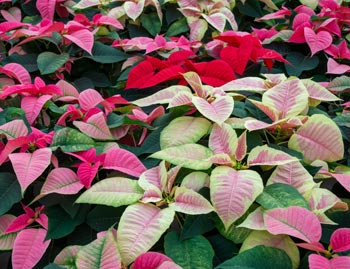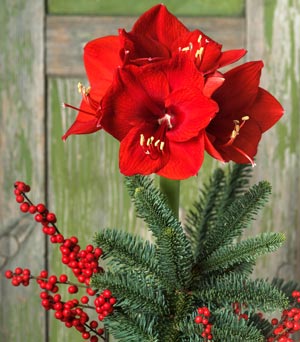Holiday Plant Care and Decorating Tips
The holidays are upon us, and thoughts of sugar plums are replacing gardening ones! While our focus may be more indoors, it is also the season for giving and receiving. Holiday plants are a welcome gift to give and receive and can add color and interest to your holiday decorations. With a little TLC they can also linger, long after the season has passed.
What types of poinsettia are there?

The red poinsettia still reigns supreme among flowering holiday plants. Yet, poinsettias are more than the traditional red, flat-bracted blooms. Today, poinsettias come in a range of colors, including:
- shades of red
- pink
- white
- yellow
- and even purple
There are speckled ones and curly flowered ones called Christmas Rose. They come in the standard 4-inch pot, or in miniature or large tree forms. There truly is a poinsettia for every home.
How do I care for my poinsettia?
With poinsettias, give them fairly bright light and even moisture. Avoid dark areas with drafts. The new varieties have been bred to hold their color for months, and can add color long after the holiday season. While they can re-bloom for another season, it is best to start with a new plant each year. Enjoy them while the color lasts, and then add them to the compost pile.
What about other more unique holiday plants?
If you want to branch out, there are other plants besides poinsettia that can add cheer to the inner landscape. Other choices include:

- amaryllis
- anthurium
- azaleas
- cyclamen
- holiday cactus
- kalanchoe
- orchids
- paper white narcissus
When receiving a holiday plant, you need to know something about plant care, to keep it attractive the longest.
Amaryllis are sold from the dry bulb stage to the bloom stage. For the longest enjoyment, start your own bulb or choose one just beginning to show color. If they are in full bloom when you get them, they may not last too long. The bulb can linger for years and re-bloom each season.
Anthurium is a rather new addition to our indoor plant repertoire. The Hawaiian flowers have the right colors to choose from: red, white or pink spathes of color, which can last for months. Some people use them as a green houseplant after bloom, since it is difficult to re-bloom them. Let them dry out slightly in between watering.
The florist azalea is different than those we plant outdoors. Keep it cool and under indirect bright light and it too can last for four to six weeks. While many gardeners attempt planting these outdoors, many don't survive the winter.
Cyclamen plants come in a range of reds, pinks and whites. These plants grow from small bulbs called corms. They prefer cool temperatures, and will decline quickly if kept warm day and night. They prefer bright light and even moisture. Too much water can cause the bulbs to rot. While many toss the plants after bloom, they can re-bloom with proper care. As the foliage begins to die back, withhold water for a few months. After a rest period, gradually begin to add water. When you see signs of new growth, increase water and sunlight.
Gerbera daisies are a semi-hardy perennial in our outside garden, but can last several weeks indoors as a potted plant. Coming in a wide range of colors, they prefer to be kept on the cool side with plenty of sunlight.
Holiday cactus are also readily available. While some call them Thanksgiving or Christmas cactus, these blooming cactus can give enjoyment year after year. Once it is in bloom, it will last longest in indirect light with even moisture. Leading up to bloom it needs cool nights and sunny days.
Get more tips for holiday cactus care
Kalanchoe is a succulent plant with a long blooming cluster of flowers. Flower color ranges from reds and oranges to yellows and whites. They like short days and long nights and warm, dry conditions. Don't overwater this plant.
You may not think of orchids during the holidays, but what showier blossom can you think of that will last for six to eight weeks with very little care? They can also live to see another day, if you so choose.
And last but not least, paper white narcissus. These lovely forced clusters of white blossoms often come artfully arranged with greenery and berries. Like the amaryllis, they are available in all stages, from dried bulbs to blooming plants. Enjoy them while they last, and then move on to something else. Re-blooming is not advised.
How do I re-bloom my holiday plant?
When the holidays are upon us, and who wouldn't welcome a blooming plant? While the care of these plants isn't difficult, re-blooming may be, and in most cases is not worth the effort. To ensure the flowers last the longest, in general, keep holiday blooming plants in a cool room, with bright, indirect light. Make sure you have an even supply of water-but avoid over watering, which is most common. Extremely warm rooms can cause flowers to fade quickly. Try to have at least a slight differential from day to night temperatures.
With so many choices to choose from, why not select several? With minimal care, these seasonal favorites are sure to add a boost to any holiday decor.
By: Sherri Sanders
County Extension Agent - Agriculture
ssanders@uada.edu